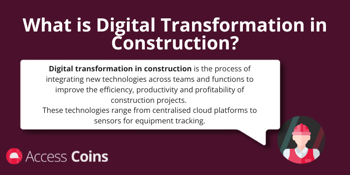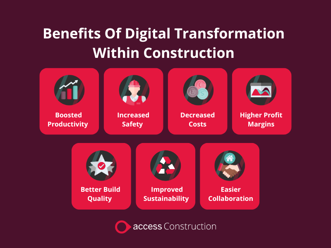How To Apply Digital Transformation in the Construction Industry
The construction industry is one of the largest in the UK, expected to reach a value of £476.6 billion by 2027. However, it also remains one of the least digitised.
It is no secret that the construction industry is resistant to technological advances, but with the UK construction sector facing many challenges and profit margins running low, the need to adapt to new technologies is more urgent than ever.
In this article, we review the benefits and challenges of digital transformation in construction, and outline approaches for construction businesses to embrace digital transformation and reap the benefits.
Contents
- What is Digital Transformation in Construction?
- Why the Construction Industry Needs Digital Transformation
- Roadblocks to Digital Transformation in the Construction Industry
- Digital Transformation Solutions In Construction
- What Are The Benefits Of Digital Transformation In Construction?
- Digital Transformation Challenges in the Construction Industry
- How To Approach Digital Transformation In Construction
What is Digital Transformation in Construction?
Digital transformation in construction is the process of integrating new technologies across teams and functions to improve the efficiency, productivity and profitability of construction projects.
These technologies range from centralised cloud platforms to sensors for equipment tracking.
Adapting new technologies across the construction project lifecycle helps construction professionals gain visibility, enhance collaboration, increase efficiencies and make data-driven decisions. Digital transformation also helps those working on-site deliver projects in a leaner and safer manner.

Why the Construction Industry Needs Digital Transformation
Few can doubt that construction is in dire need of modernisation.
The figures speak for themselves. Productivity has remained flat in the construction industry in the past 50 years. The ONS reports that construction output per hour has seen little movement since 1970, diverting extremely from the general trend, where output per hour across the UK has more than doubled since 1970.
While other industries are using advances in digital technology to boost productivity, the construction sector has been slow to benefit from the opportunities presented by the dawn of ‘Industry 4.0’.
However, a 2023 report by the McKinsey Global Institute found that construction companies that embrace digital transformation see a 15% average increase in productivity and a 6% reduction in costs.
Lead your Digital Transformation with Access Coins
Access Coins is a centralised platform for construction management, built for the industry.
Roadblocks to Digital Transformation in the Construction Industry
While construction has a reputation for slow adaption of innovation, an aversion to technology isn’t the only reason why digital transformation is hard for construction. There are unique aspects to construction which makes digital transformation more difficult than other sectors.
Construction Projects are Fragmented
It is rare that a single company handles a build end-to-end. General contractors will hire subcontractors and specialists, making project-wide coordination difficult as different stakeholders adapt different technologies.
Construction Projects are Unique
Every construction project is distinctive, from contract to design to delivery. A lack of repetition and standardisation in the industry can make it difficult to implement digital solutions across projects.
Construction Projects Have a High Workforce Turnover
While offices and HQs may be able to adapt to new technologies, those working on project sites see a high turnover and may not remain from one project to another. The time investment in training those on-site to adapt to new ways of working slows the digital transformation wave.
Digital Transformation Solutions In Construction
Construction ERP
ERP (Enterprise Resource Planning) is a digital solution, usually cloud-hosted, which integrates and centralises disparate company data and functionality into a single platform. Accessible via browser or mobile app, ERP covers a range of functions including financials, workforce management, supply chain management and project management.
ERPs built specifically for the construction sector offer increased functionality, workflows and project views built to suit construction companies.
Read more about ERP in Construction –
Benefits of using ERP in the Construction Industry
Construction ERP vs Generic ERP: Key Differences & Features Explained
Client Portals
Contractors can build trust with their clients through client portals which offer visibility across project timelines, development and status through real-time dashboards, documentation and progress photos. Client portals help with both accountability and keeping to project scope. Mistakes can be flagged faster and communication is far faster and easier on a shared portal. This leads to a reduction in rework and stronger relationships with clients which lead to repeat work.
BIM (Building Information Modelling) Software
BIM is a technology which has transformed the preconstruction process. Using virtual models, collaborators including architects, engineering and construction teams are able to work together to visualise and edit design-build concepts.
Cloud-hosted designs makes collaboration and collaboration easy, meaning all teams are on the same page across a project. Planning errors are flagged before a project kicks off and changes can be made to a model to account for scope changes such as costs or additional client demands.
Internet of Things (IoT)
The Internet of Things (IoT), the use of remotely connected sensors and devices, is revolutionising the construction industry by providing real-time data and insights that can improve efficiency, safety, and quality.
IoT sensors can track the performance of construction equipment and predict potential failures, allowing for proactive maintenance and reducing downtime. IoT-enabled devices can track the location and usage of equipment, improving asset management and preventing theft.
Construction managers can also remotely monitor site conditions, identify potential issues early on, and make informed decisions to optimise the construction process.
Augmented Reality (AR) and Virtual Reality (VR)
Augmented reality (AR) and virtual reality (VR) are some of the newest technologies to find applications across construction. AR and VR allow architects and engineers to experience their designs in a fully immersive environment, identifying potential issues early in the process.
VR can also be used to simulate construction sites to help identify potential hazards and provide interactive training environments for on-site workers.
Mobile and Cloud Technology
Evolving from on-premise systems, working on cloud software and remote mobile applications helps link the site to the office for faster collaboration across teams. Storing data on the cloud is safer, faster and easier to manage than on local servers.
Mobile applications can also be used for field data collection, real-time communication and remote access to vital project documentation.

What Are The Benefits Of Digital Transformation In Construction?
Significantly Boosted Productivity
Digital technologies can help to streamline processes, automate tasks, and improve communication across the construction project lifecycle. This can lead to significant time and cost savings, alongside increased productivity. Time is saved on repetitive or manual tasks, and entire teams working on construction schemes can view the same data and updates in real-time, leading to faster-moving projects.
Reduced Costs
As UK construction costs continue to skyrocket (a 2025 report by BCIS predicts a 17% rise in building costs over the next five years) the ability of construction technology to reduce and optimise costs is one of the leading benefits of digital transformation.
Construction technology harnesses the power of real-time financial data, big data analysis and AI to optimise resource planning, cut overspend and waste and eliminate human errors. Construction financial management software can also help construction professionals easily spot outliers, accurately track budgets and protect construction margins.
Increased Safety
Digital technologies can help to improve safety on construction sites by providing real-time data on hazards, risks, and compliance. This can help to prevent accidents and injuries, a continuing issue within the industry. Worker fatalities in construction are more than double than any sector in the UK, and increasing safety remains an imperative in the sector.
Construction technology such as wearable sensors, inspection drones and real-time logging of potential risks via mobile apps help on-site workers feel safer and happier to work, boosting wellbeing and improving what can be a sometimes challenging work culture.
Better Build Quality
Digital technologies can help to improve the quality of construction projects themselves by providing more accurate information and data. This can lead to fewer defects and rework, a significant contributor to productivity loss, and result in improved relationships and repeat projects from clients.
Read more about how to avoid rework in construction.
Improved Sustainability
With increasing pressure on construction to decrease emissions and work sustainably and recent legislation such as The Future Homes and Buildings Standards, more construction leaders are looking to digital transformation to enhance sustainability efforts.
End-to-end construction technology such as Construction ERP uses automation, workflows and continuous improvement helps construction companies build more sustainably. Reductions in waste and rework (responsible for 20% of the sector’s output), centralised compliance documentation and support for sustainable modular construction are some of the ways digital transformation can help construction companies meet sustainability targets.
Simple Collaboration
There are endless benefits to improving collaboration in construction projects, and digital technologies can help to improve collaboration between different stakeholders at every step of the construction project lifecycle. This leads to more confident decision-making and more efficient execution of projects.
Construction management software can provide a centralised location for all stakeholders and subcontractors to share feedback, progress reports or blockers. Sharing the same information across parties eliminates the errors that come from siloed communication (email threads, phone calls, instant messages), reducing the risk of delays.
Better Customer Experience
Alongside improvements in internal collaboration, digital transformation also enables contractors to work much closer with their clients. Virtual reality and BIM software have transformed how clients can visualize designs, and cloud-based customer portals allow clients to track progress and share feedback remotely during the build.
This transparency through digital transformation results in a reduction of rework, improved client relationships and increased chances of future collaborations.
Better Decision Making
One of the core advantages of construction technology is its ability to collect, centralize and present real-time data from a variety of sourced. Data analytics, dashboards and reporting has the potential to transform construction projects, especially in its ability to facilitate fast, confident and data-driven decisions. Better-informed decisions at every level of a construction project lead to significantly improved outcomes.
Digital Transformation Challenges in the Construction Industry
While investing in digital transformation can result in significant positive impacts on construction businesses, making the change also brings challenges. Many factors can contribute to digital transformation falling short of expectations, and the unique position of the construction industry has led to a slow adoption of technology compared to sectors such as manufacturing.
Challenges when applying digital transition in the construction industry include:
Initial Cost
While the benefits of digital transformation are clear, many construction leaders will balk at the initial costs involved in purchasing and implementing construction technology solutions.
Implementation, training and adoption also requires time, resources and money which may be disruptive in the short-term.
Project-Based Nature of Construction
With the project-based nature of construction, it can prove difficult to implement digital transformation at-scale. Every project will often involve a unique set of suppliers, subcontractors and clients who won’t have the time or incentive to adapt their working methods to new technologies.
To overcome this hurdle, it is beneficial for construction businesses to research and invest in solutions that are tailored to the construction industry, such as construction accounting software that tracks individual projects.
Worker Adoption
Construction has an aging workforce, and while there are many exceptions to the rule, older employees are often unwilling to embrace technology, preferring instead to stick to ‘the old ways’.
Approach to training is key to convincing workers in construction of the benefits of digital transformation, alongside choosing technologies which are designed intuitively and easier to adopt by those who are cautious about new solutions.
Poor Data Management
Data is core to digital transformation, but poor data management is still an issue in the construction industry. With so much data coming from siloed teams and projects, much of it is classed as ‘bad data’ – inaccurate, out-of-date or impossible to integrate with other sources.
A study by Autodesk revealed that poor data management cost the global construction industry a staggering $1.85 trillion in 2020 alone.
Adopting technology without putting data strategy first can lead to further issues down the line. Building a construction technology stack around a single-source-of-truth for data, such as a construction ERP platform, solves many of the data management issues which later leads to poor performance of new construction technologies.
Transform your data management with Access Coins
By providing a single source of truth for your data, Access Coins reduces risk, increases productivity and gives your team the freedom to work collaboratively.
How To Approach Digital Transformation In Construction
Define Your Objectives
A successful digital transformation must begin with stakeholders agreeing with what it is they want to see transformed. Which processes contribute the most to stalled productivity, cost overruns or block successful risk management?
Stakeholders also need to outline what success looks like – setting timelines, targets and assigning those accountable. Alignment and agreement on these targets will lead to a more successful outcome.
Analyse Your Current Data Environment
The fact is that most contractors simply do not know what data they have. A typical contractor will be tracking multiple data points across a range of sources, both digital and hardcopy. This includes important data points such as:
- Schedules
- Plant, equipment and material costs
- Subcontractor prices
- WIP
- Timesheets
- Labour rates
Many build their own libraries of this data and often use complicated, bespoke spreadsheets to track it all. This is a manual process – and if something goes wrong, it is a painstaking task to go through the formulas and lines of data to find the problem.
And if they don’t know what data is available, how can they possibly begin to use it to improve business efficiencies, boost productivity and increase margins? As a result, the starting point for digitising a construction business is to understand what data is where and how it is used.
Choose the Most Impactful Solutions
When researching the best construction technology for specific needs, construction leaders need to keep many elements in mind. A good approach is to keep a list of ‘must-haves’ and ‘nice-to-haves’ to keep a manageable list of vendors.
When communicating with construction technology vendors, contractors need to enquire around:
- Implementation
- Training
- Scalability
- Customisation
- Integrations
- Accessibility
- Compliance
- Support
- Cost structures
To get a true idea of the impact of the chosen technology.
Read our guide to the best questions to ask construction ERP vendors.
Secure a Buy-In by Proving ROI
Applying digital transformation to a construction company will be more impactful if enthusiastic buy-in is secured from major stakeholders. The best way to communicate the benefits of digital transformation is to focus on the potential ROI of the technology in both the short and long-term.
Remember that ROI doesn’t just come from saved costs, but also from improved productivity, faster decision-making, enhanced collaboration and improved client satisfaction.
Read our guide on how to build a business case for construction ERP.
Plan Training, Support and Communication
The only way to solve the challenge of worker adoption is to plan training, internal messaging and ongoing support ahead of implementation. Work with the vendor to ensure all teams are confident in using the solution, ensuring training is adapted to different job roles and needs.
It will also help to create internal training materials for smooth onboarding of new hires.
Access Coins is The All-In-One ERP for Construction
Access Coins is a comprehensive, all-in-one ERP system that allows construction professionals to manage risk, capture and manage data and streamline day-to-day management of their business.
Designed specifically for the challenges of the construction industry, Access Coins’ integrated modules are built to manage the entire lifecycle of a construction project.
With real-time data insights at its core, Access Coins gives construction businesses total visibility over their projects. Confidently make data-driven decisions that can help boost margins, assess profitability and manage risk.
More construction software information, guidance and advice

What Is Cost Value Reconciliation (CVR) In Construction?
Go to article
What Is Job Costing In Construction?
Go to article
Benefits of Using ERP In The Construction Industry – Reviewing The Pros and Cons Of An ERP System
Go to article

